News Articles
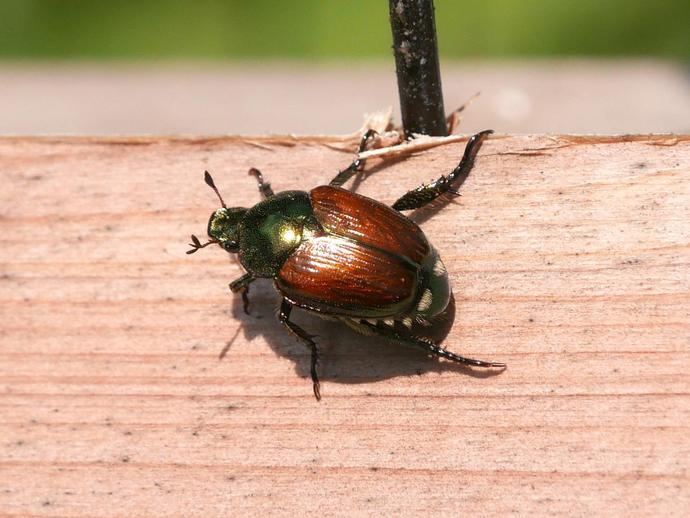
Here we see a Japanese beetle (Popillia japonica) quietly contemplating flying over to my ...
June 30, 2020
Here we see a Japanese beetle (Popillia japonica) quietly contemplating flying over to my long-suffering persimmon sapling to continue skeletonizing its leaves. As the common name suggests, these beetles are native to Japan, and they're not terribly destructive in their home country because they're kept in check by natural predators. Elsewhere, however, these beetles are a menace to a wide variety of agricultural crops. Japanese beetles were first discovered in the U.S. in 1916 at a nursery near Riverton, New Jersey. It's believed they were accidentally imported to the U.S. as stowaways in a shipment of iris bulbs a few years earlier. As of 2015, these beetles have spread to all but nine western states in the U.S., and ...
Take a virtual field trip to the mountainous landscape of central Appalachia in the western part ...
June 29, 2020
Take a virtual field trip to the mountainous landscape of central Appalachia in the western part of Virginia in this video produced by former VMNH research intern Aryanna James! Aryanna is currently a masters student at Virginia Tech working in the Entrekin lab of Aquatic Entomology and conducting research that focuses on the effects of mining-induced salinization on macroinvertebrate communities in headwater streams of Central Appalachia. In this video, Aryanna takes us to the mountainous landscape of Central Appalachia in western Virginia and some of the streams that she studies there.
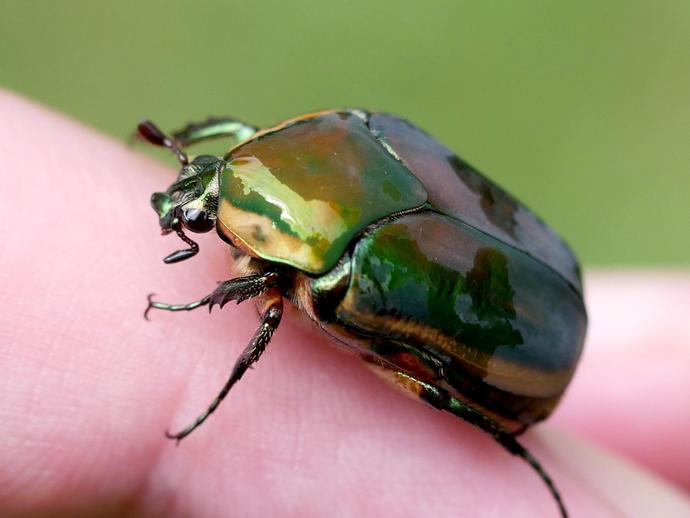
When I was a little kid ...
June 29, 2020
When I was a little kid, my grandpa showed me how to tie a string around the leg of a green June beetle (Cotinis nitida). The beetle will take flight, pull all the slack out of the string, and then fly around your head in a circle. This is probably not the nicest thing to do to June beetle, but it was pretty entertaining! As their name suggests, these beetles start showing up around June here in southwest Virginia, and they can usually be spotted flying low over yards. It's believed that they're attracted to decaying organic matter because it provides a good place to lay their eggs. Anecdotally, I remember that I would always see a ton of June beetles at the spot where my grandpa dumped all of his old grass clippings, ...
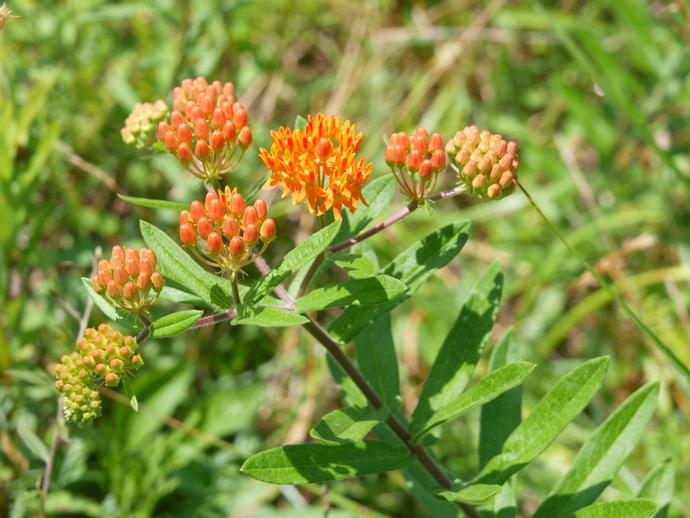
I had always heard this plant referred to as "chigger weed ...
June 28, 2020
I had always heard this plant referred to as "chigger weed," and I was told that if I touched it, I would get covered in chiggers (tiny red mites that bite you and cause horrible itching). I have no idea where that story came from, but this plant isn't any more prone to chiggers than any other plant out there. In fact, it's more commonly known as "butterfly weed," which is much more appealing. Asclepias tuberosa is a member of the milkweed family, and it's native to eastern and southwestern North America. It's a wonderful plant for attracting butterflies -- not to mention hummingbirds and other pollinators -- and it serves as an important food plant for monarch butterfly caterpillars! Butterfly weed flowers from ...
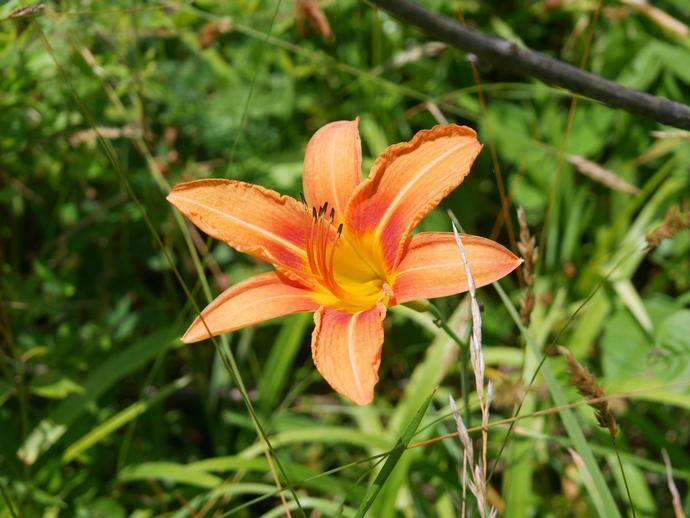
At the risk of revealing how the sausage is made ...
June 27, 2020
At the risk of revealing how the sausage is made, I have a confession to make: I am not actually a walking encyclopedia of nature knowledge. When I write these posts, I often have to consult an expert to identify the plant or critter I've photographed, and then once I know what I have, I research it and learn all about it. At other times, I'll THINK I know all about the thing I've photographed only to do some research and discover that I didn't know as much as I thought I did. Case in point: Hemerocallis fulva, better known as the orange daylily or tiger daylily (or the ditch lily, if you're feeling less charitable). I had always thought these beautiful flowers were native to the U.S.; as it turns out, they're an ...
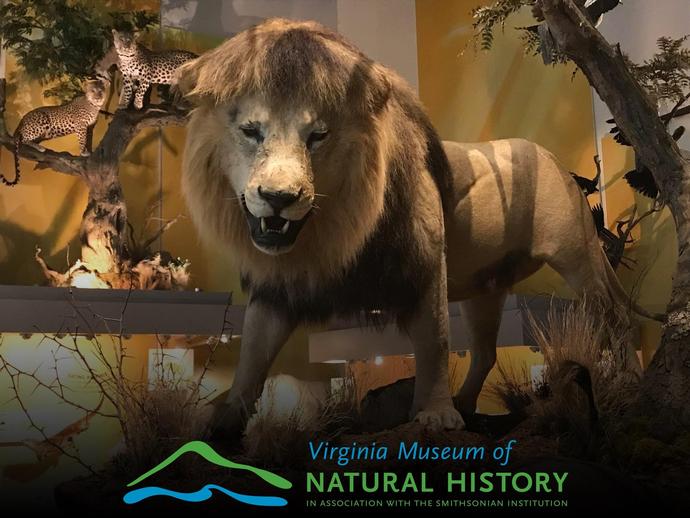
SPECIAL HOURS AND FREE ADMISSION WEDNESDAY, JULY 1!
June 26, 2020
SPECIAL HOURS AND FREE ADMISSION WEDNESDAY, JULY 1! The museum is offering FREE admission and special visitor hours on Wednesday, July 1 from 1 to 5 p.m. in conjunction with an American Red Cross Blood Drive being hosted at the museum in memory of our good friend and colleague, Cindy Gray. Please note that these are special hours, as the museum is currently closed Mondays-Thursdays. If you are interested in donating to the Blood Drive, please visit the American Red Cross website at www.redcrossblood.org to schedule an appointment prior to traveling to the museum. The location zip code is 24112. Donations are not a requirement to receive free admission. IMPORTANT VISITOR INFORMATION *Face coverings are required of all ...
Is it a solid, liquid or gas?
June 26, 2020
Is it a solid, liquid or gas? VMNH Educator Kayla Lacy, with the help of her nephew and assistant, Ciaran, create "Oobleck" and try to decide what state of matter the creation is!
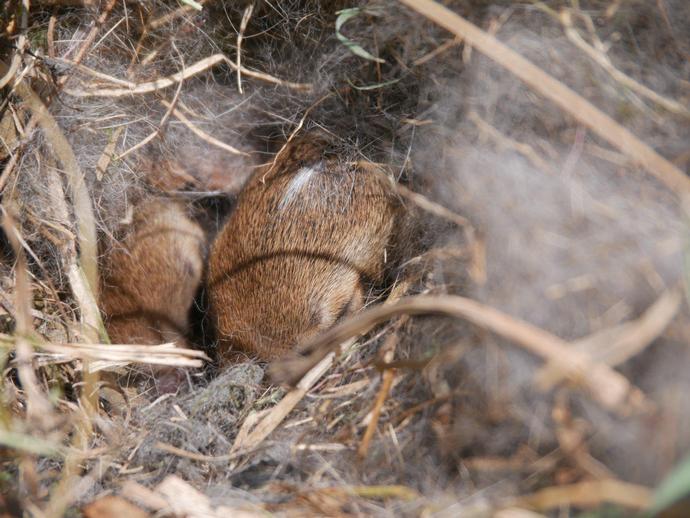
There's a story behind today's nature update!
June 26, 2020
There's a story behind today's nature update! I have a nice neighbor who comes and cuts and bales the hay on my old family property. He started cutting the hay a couple days ago, and as I was walking through a newly-cut field taking nature photos, I nearly tripped over a rabbit nest! These baby rabbits are almost certainly eastern cottontails (Sylvilagus floridanus). When rabbits are ready to give birth, they dig a slanted hole in some soft soil and line the hole with plant material and fur. The mother will come by the nest to nurse about twice per day. The babies begin to open their eyes around four to seven days, which leads me to believe that the babies in this litter were less than a week old! Baby eastern ...
When many people think of paleontology ...
June 25, 2020
When many people think of paleontology, they think of ancient giants, such as Acrocanthosaurus and megalodon, but even the smallest of animals have an incredible story to tell. In this episode of "Tales of Ancient Life", VMNH Assistant Curator of Paleontology Dr. Adam Pritchard highlights some of the "unsung heroes" of paleontology - the tiny, vertebrate animals (animals with backbones) that often get overshadowed figuratively and literally by the giants of our planet's history.
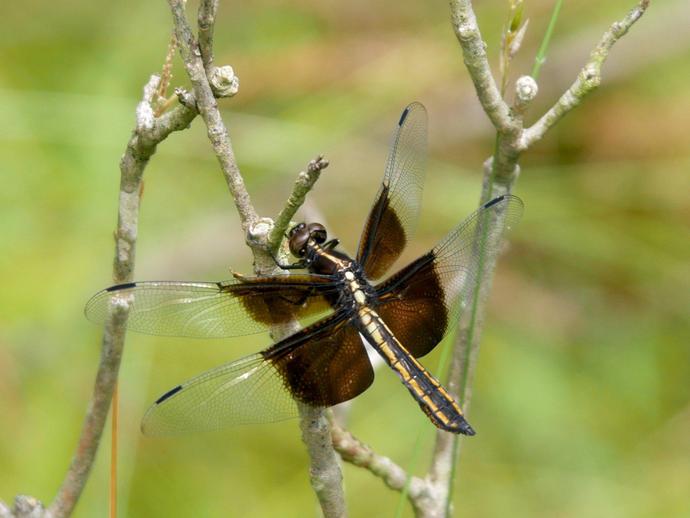
This striking dragonfly is a female Libellula luctuosa, better known as the "widow skimmer
June 25, 2020
This striking dragonfly is a female Libellula luctuosa, better known as the "widow skimmer." It's a pretty common dragonfly and can be found across the United States (except in some of the higher parts of the Rocky Mountains). Dragonflies look similar to a related group of insects, the damselflies (Zygoptera). It's easy to tell the difference, however; most dragonflies hold their wings flat and away from their bodies, as seen here, while damselflies fold their wings while they're at rest. Damselflies are also weak fliers, while dragonflies are incredibly agile. If you're an insect, the dragonfly is a predator to be feared. They spend their larval stage as predatory aquatic nymphs. When they emerge from the water and ...
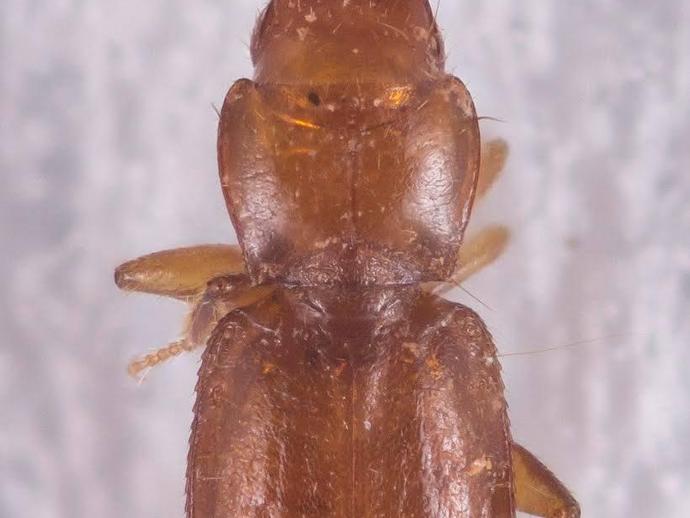
I posted my first nature update on March 17 ...
June 24, 2020
I posted my first nature update on March 17, which means that today marks 100 DAYS of nature posts! In recognition of this large, round number, I figured I should post something a little special, so here's an undescribed species that was found right on my family property! Awhile back, former VMNH Research Technician and current Clemson University grad student Curt Harden set up some subterranean beetle traps on my property. These are special traps of Curt's own devising designed to capture miniscule ground beetles. Curt is one of just a handful of folks in the world who studies these beetles! When he checked the traps last November, he ended up finding a new species of ground beetle belonging to the genus Anillinus! ...
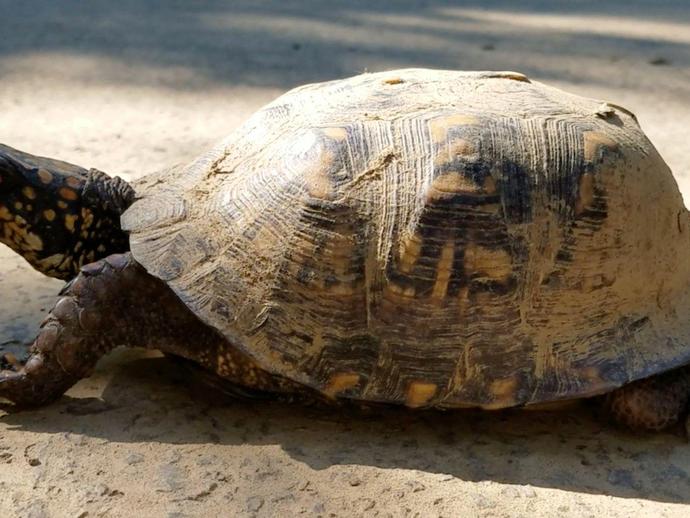
Covid-19 Virtual Herpetological Survey Presented by the Virginia Herpetological ...
June 24, 2020
Covid-19 Virtual Herpetological Survey Presented by the Virginia Herpetological Society Saturday, June 27th Our friends at the Virginia Herpetological Society are hosting the Covid-19 Virtual Herpetological Survey this Saturday! (Please note that this event is not being hosted by the Virginia Museum of Natural History.) FROM THE VHS WEBSITE Just because we are not able to herp together this summer doesn't mean we can't herp at all! This month, we will host a virtual survey state-wide! THIS SATURDAY, June 27th from 12:00am to 11:59pm, we encourage you to find as many herps as you can and report them to us! All you need to do is tell us how many people are in your group, which county / independent city you are herping in, ...
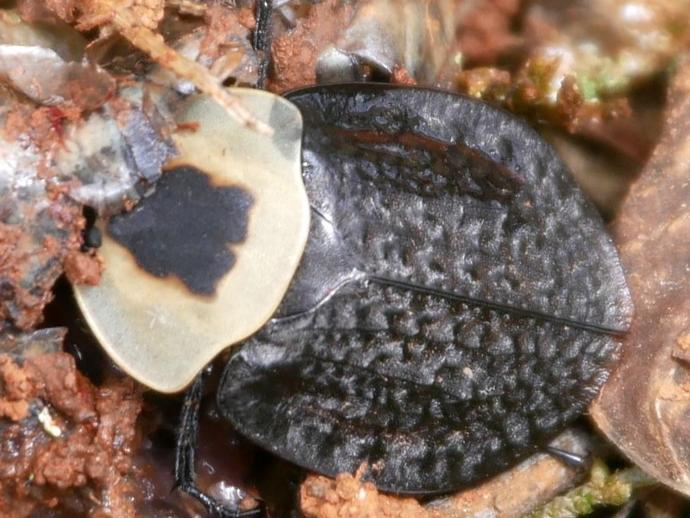
The other day, I found a skink in my yard that had met a mysterious and untimely end
June 23, 2020
The other day, I found a skink in my yard that had met a mysterious and untimely end. While this was unfortunate, it did allow me to spot a beetle that I'd read about but never before seen in person: Necrophila americana, the American carrion beetle. As you might imagine, these beetles eat dead animals (and fungi), and they also lay their eggs in dead critters, which then provide a tasty treat for the larvae once they hatch. The circle of life can be kind of gross, but it's a better alternative than having dead animals all over the place. In addition, once these beetles find a suitable dead thing, they also eat fly larvae and the larvae of other types of carrion beetles before laying their eggs. This gives their eggs ...
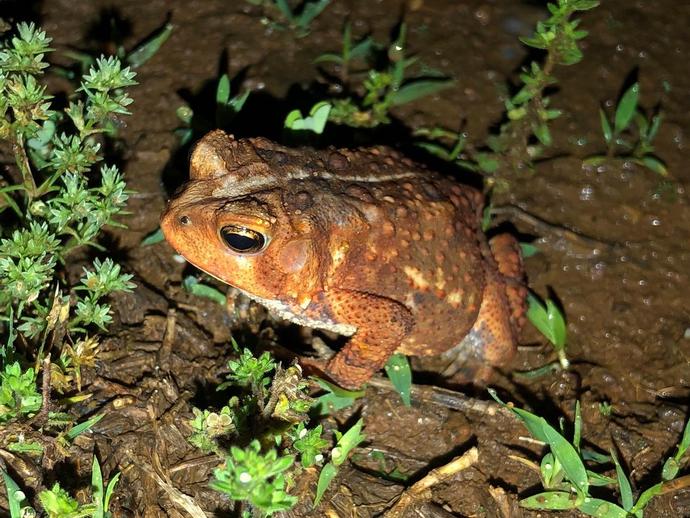
The eastern American toad (Anaxyrus americanus americanus) is a common sight in southwest ...
June 22, 2020
The eastern American toad (Anaxyrus americanus americanus) is a common sight in southwest Virginia and it's the most common subspecies of the American toad. It can be found throughout much of eastern North America (although it doesn't extend much farther south than North Carolina). Another subspecies, the dwarf American toad (A. a. charlesmithi) can be found in Arkansas and parts of neighboring states, while a third subspecies, the Hudson Bay toad (A. a. copei) can rarely be found in isolated populations in northern Ontario. The eastern American toad can be spotted in a wide variety of habitats. All it needs are a variety of bugs to eat, a few damp spots where it can hide, and a shallow pool in which to breed and lay eggs. ...
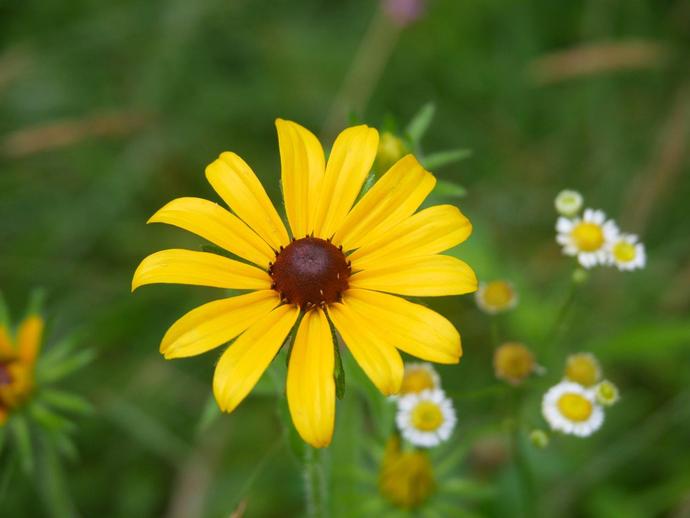
Even folks who aren't interested in wildflowers can likely identify black-eyed Susans (Rudbeckia ...
June 21, 2020
Even folks who aren't interested in wildflowers can likely identify black-eyed Susans (Rudbeckia hirta). While this member of the sunflower family is native to eastern and central North America, it can be found in all 48 contiguous states and every Canadian Province! If you like butterflies and other pollinators around your home, black-eyed Susans are a great attractant. They're also the host plant for a handful of caterpillars, such as the silvery checkerspot, the gorgone checkerspot and the bordered patch. The black-eyed Susan is a pretty forgiving plant. They bloom from late spring/early summer until the first frost, they tolerate heat, drought, and full sun, and they generally aren't attractive to deer. If you have ...
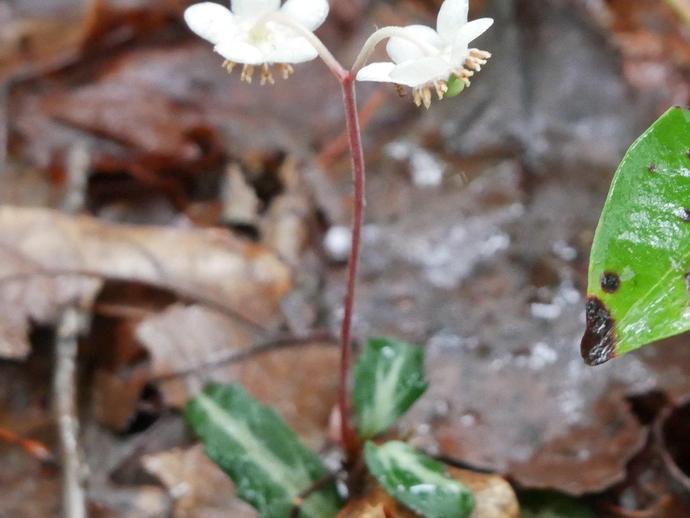
Spotted wintergreen (Chimaphila maculata) is in bloom right now!
June 20, 2020
Spotted wintergreen (Chimaphila maculata) is in bloom right now! This perennial evergreen herb is a fairly common sight in the forests of southwest Virginia, although it's pretty rare in many parts of its range. Its variegated (differently colored) leaves make it fairly easy to spot. It prefers sandy, well-drained soil and it can tolerate acidic soil. The Creek Indians referred to this plant as pipsisikweu, which translates to "breaks into small pieces." It was believed that leaves could be made into a tea that would break down kidney stones and gallstones. The crushed leaves were also used as a poultice for cuts and sores. There is evidence that the plant does have a range of antiseptic and antibacterial properties, but ...
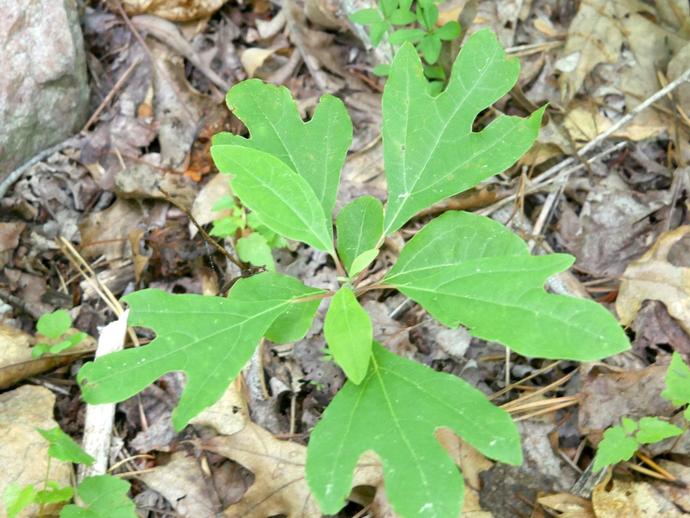
White sassafras (Sassafras albidum) is native to the eastern U
June 19, 2020
White sassafras (Sassafras albidum) is native to the eastern U.S., and it's long been a very important tree for a wide variety of commercial uses. When the English first came to America, they exported sassafras to Europe where it was converted into a drink called "saloop" that was supposed to have medicinal qualities. Sassafras quickly became touted as a cure-all for a wide variety of maladies. The bark of sassafras contains safrole oil, an aromatic chemical that was used as an additive in everything from toothpaste to root beer until the FDA banned its use in 1960. It's also used in the production of the psychoactive drug MDMA! (I don't know the rest of the ingredients, nor would I share the recipe if I did.) Because the ...
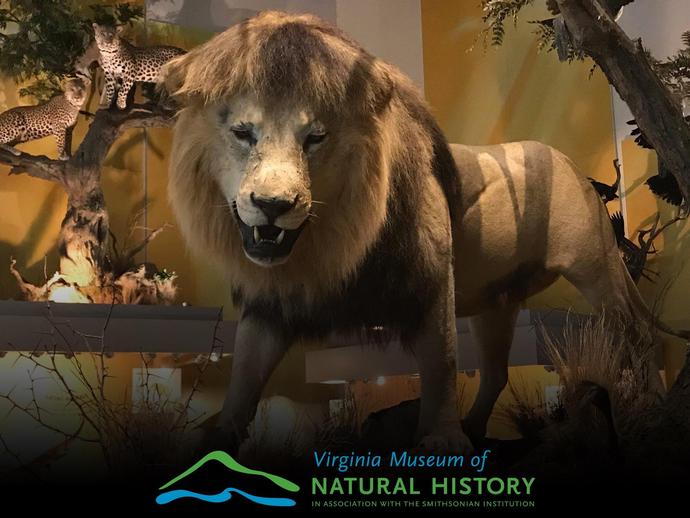
FREE admission to the museum today! The museum is now open Fridays and Saturdays from 9 a
June 19, 2020
FREE admission to the museum today! The museum is now open Fridays and Saturdays from 9 a.m. to 5 p.m. Through Labor Day weekend, the museum is open on Sundays from 1 to 5 p.m. The museum is closed all other days. To mark the reopening of the museum, admission is free today only (6/19/20)! IMPORTANT VISITOR INFORMATION *Due to crowd size limitations, please note that the museum may have to delay or deny entry to visitors. At this time, the museum is not taking visitation reservations. *Face coverings are required of all persons aged 10 and over for entry into the museum (some exceptions apply). The museum will not have face coverings available to visitors. Go to www.vmnh.net/visit for more information, including a list ...
Just how much larger is the queen than the workers inside the museum's leafcutter ant colony?
June 18, 2020
Just how much larger is the queen than the workers inside the museum's leafcutter ant colony? See for yourself! As you can see, the workers are always crawling around the queen and tending to her needs, like feeding her and cleaning her. Thanks to VMNH Research Technician Liberty Hightower for taking this short clip of a rare queen ant sighting. When the queen moves (either on her own or by force of the other ants), it is to get her to what is deemed to be the best temperature and humidity available inside the colony, as well as where she would be safest from possible predators. Of course, sometimes the queen and the workers have different ideas of where the best place within the colony is for her. Staff sometimes observe ...
VMNH Assistant Curator of Paleontology Dr
June 18, 2020
VMNH Assistant Curator of Paleontology Dr. Adam Pritchard teaches us about one of the largest flying birds to ever live, Pelagornis.
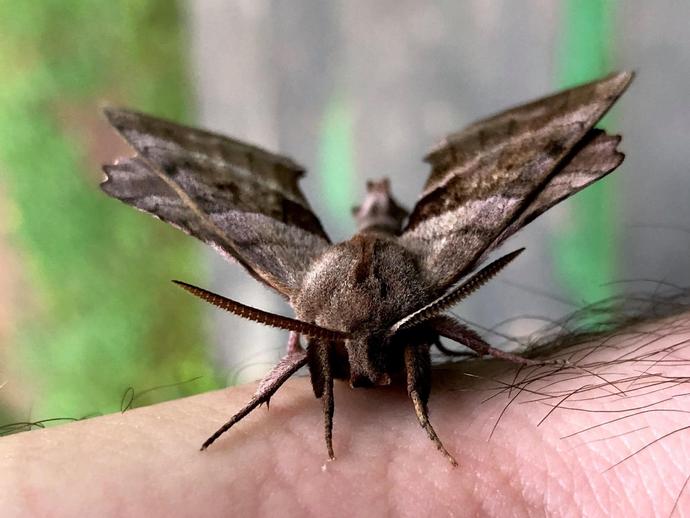
One of my favorite things about this time of year is the wide variety of beautiful moths that ...
June 18, 2020
One of my favorite things about this time of year is the wide variety of beautiful moths that are drawn in by my porch light. This moth is Amorpha juglandis, the walnut sphinx moth, and it can be found in deciduous forests east of the Rocky Mountains. As adults, these moths do not eat and are mainly active during the early hours of the night. The caterpillars eat the leaves of a variety of trees, including not only walnut, but also alder, hickory, beech, hazelnut, and butternut. One of the neatest features of the walnut sphinx caterpillar is its defense mechanism. If the caterpillar is attacked by a bird, it expels air from two spiracles (openings in an insect's exoskeleton) in its abdomen, which produces a high-pitched ...
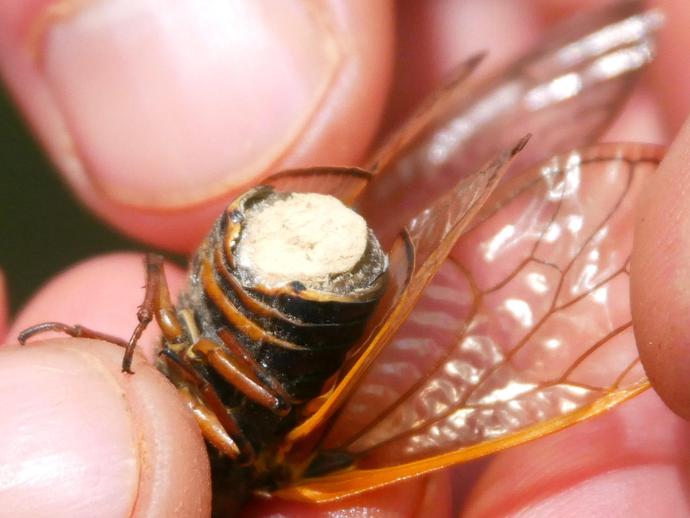
Hey everybody!
June 17, 2020
Hey everybody! Who wants to learn about something gross?!? This is one of our three species of periodical cicada in Brood IX, Magicicada septendecim. However, we're not going to talk about the cicada; today's post is about the odd white substance on its abdomen. That white substance is a fungal pathogen (disease-causing fungus) called Massospora cicadina. Don't worry, it's not harmful to humans, and in fact, it only targets periodical cicadas; annual cicadas are unharmed. This is a very unusual fungus, and it's actually believed that it may have the longest life cycle of ANY fungus. It can infect periodical cicadas during their first year of life, but it will remain dormant until they emerge from the ground and molt ...
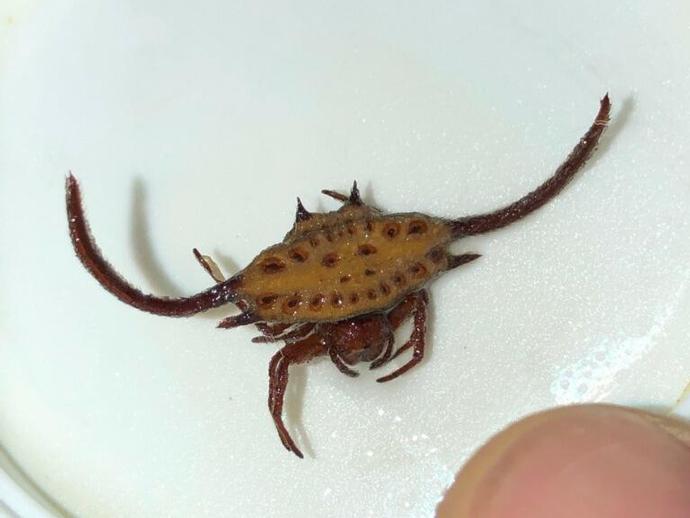
Today ...
June 16, 2020
Today, while working on organizing and updating VMNH's vast myriapod collection, VMNH Collections Assistant Dr. Jackson Means came across this stunning spiny orb-weaver spider tucked in a sample of Tanzanian millipedes. This long-winged kite spider (Gasteracantha versicolor) is the first of it's kind in VMNH's invertebrate collection.
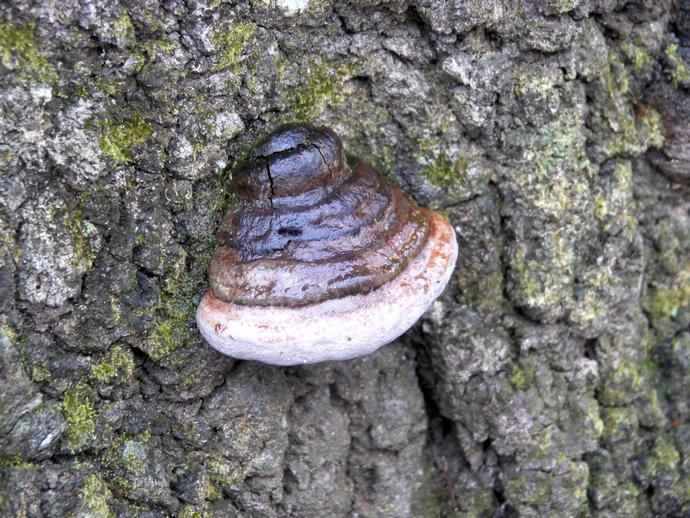
Shelf fungi, also known as polypores, are not your ordinary mushroom
June 16, 2020
Shelf fungi, also known as polypores, are not your ordinary mushroom. They fulfill the same basic job as a mushroom -- they produce and disperse spores to continue the species -- but unlike your typical mushroom, they frequently have a woody or leathery texture and some species can live for years! The name "polypore" stems from the fact that these mushrooms don't have gills underneath the cap, they have tiny pores. If the shelf fungus is the woody variety and resembles a horse's hoof (like this one does), the structure is commonly called a "conk." Shelf fungi add a new layer of spore tissue each growing season, sort of resembling the growth rings in a tree. Sometimes there can be two growing seasons in a year, however, ...
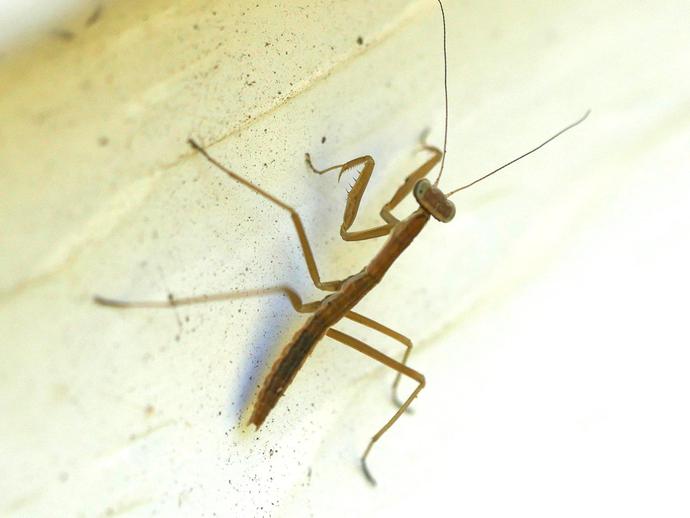
Keep an eye peeled in the spring, because you're liable to see some tiny praying mantids!
June 15, 2020
Keep an eye peeled in the spring, because you're liable to see some tiny praying mantids! This mantid is probably a Carolina Mantis (Stagmomantis carolina), according to VMNH Associate Curator of Invertebrate Zoology Dr. Kal Ivanov. This species is fairly common and can be found throughout much of North America, Central America, and South America. It's often difficult to identify the Carolina mantis by color alone, because this species can vary from brown to green to gray. When the juveniles molt (shed their old exoskeleton), they adjust their color to better match their surroundings and blend into their environment! If you find a mantid in your garden, you're in luck. These guys are voracious predators and are a ...
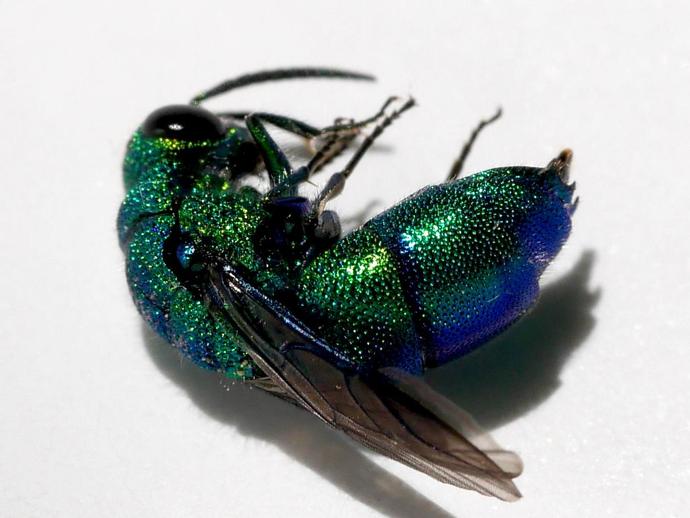
This beautiful wasp is a member of the family Chrysididae ...
June 14, 2020
This beautiful wasp is a member of the family Chrysididae, also known as cuckoo wasps, emerald wasps or jewel wasps. And despite how it looks, it's not dead! These wasps have concave abdomens and can curl up into a ball when they feel threatened (by a camera for example). You won't find a big, buzzing nest of these wasps anywhere; they're solitary wasps, and they're also parasites, which is how they get the common name "cuckoo wasp." Just like the cuckoo family of birds, they lay their eggs in the nests of unrelated host species! I generally spot a fair number of these wasps on my back porch when the carpenter bees are out in force because they like to lay their eggs inside carpenter bee galleries. The cuckoo wasp ...
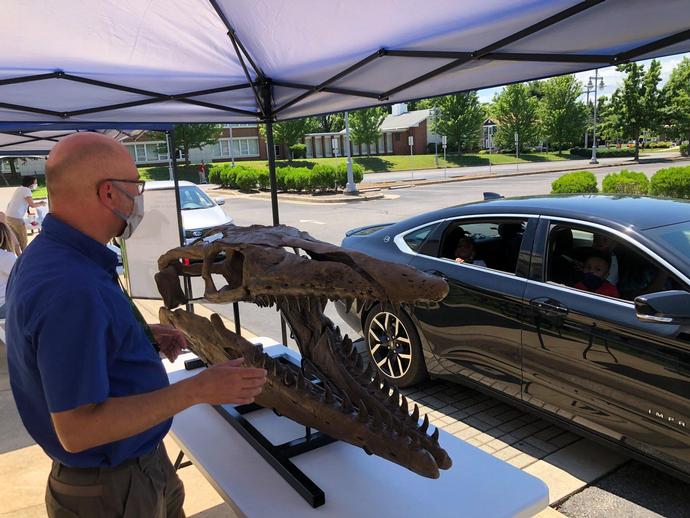
Although we couldn't host this year's Reptile Festival ...
June 13, 2020
Although we couldn't host this year's Reptile Festival, we were happy to be able to offer a small piece of it during the Drive-thru Reptile Experience this afternoon!
Liberty Hightower is both a research technician and a big animal lover ...
June 13, 2020
Liberty Hightower is both a research technician and a big animal lover, and in this video, she talks about Ashitaka, her pet bearded dragon!
In this video ...
June 13, 2020
In this video, VMNH Administrator of Science Ben Williams ventures into the woods and discusses the Eastern worm snake Carphophis amoenus amoenus.
Dr
June 13, 2020
Dr. Joe Keiper, executive director of VMNH, discusses the ancient reptile Tanytrachelos and other Solite fossils!
VMNH Educator Kayla Lacy demonstrates a fun snake craft that you can conduct from the comfort of ...
June 13, 2020
VMNH Educator Kayla Lacy demonstrates a fun snake craft that you can conduct from the comfort of your own home with your children!
In this video ...
June 13, 2020
In this video, VMNH Educator Kayla Lacy and her assistant, Ciaran, show us a fun activity that can be used to teach children about animal camouflage!
The Eastern copperhead (Agkistrodon contortrix) is one of just three venomous snakes in Virginia
June 13, 2020
The Eastern copperhead (Agkistrodon contortrix) is one of just three venomous snakes in Virginia. In this video, Larry Mendoza, of the Virginia Herpetological Society, tells you all about it!
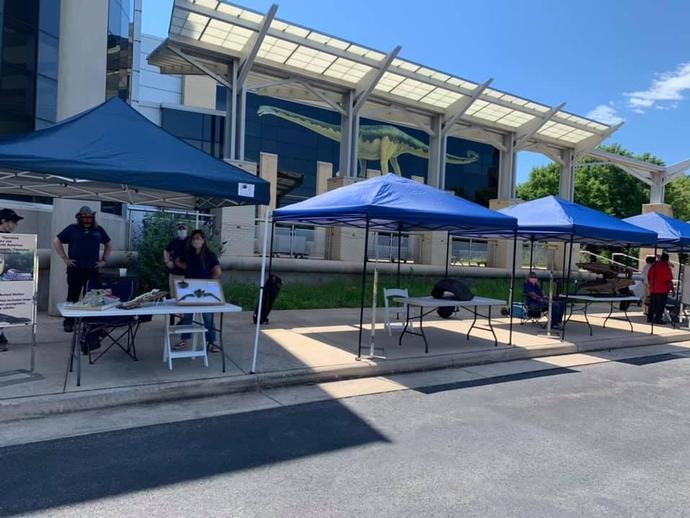
Setting up for our FREE Drive-through Reptile show!
June 13, 2020
Setting up for our FREE Drive-through Reptile show! Drop on by anytime from noon to 3pm for a few minutes of live reptiles, fossils, and fun! ����
The cottonmouth (Agkistrodon piscivorus) is one of Virginia's few venomous snakes and can be ...
June 13, 2020
The cottonmouth (Agkistrodon piscivorus) is one of Virginia's few venomous snakes and can be found in the southeastern portion of the Commonwealth. It can also be found in this video from Larry Mendoza! Larry is with the Virginia Herpetological Society, and he and his snakes were a huge hit at our last Reptile Festival!
The Eastern garter snake (Thamnophis sirtalis sirtalis) is the official state snake of Virginia, ...
June 13, 2020
The Eastern garter snake (Thamnophis sirtalis sirtalis) is the official state snake of Virginia, and Larry Mendoza, of the Virginia Herpetological Society, has one to show off!
Larry Mendoza shows off a seldom-seen mole kingsnake (Lampropeltis rhombomaculata)!
June 13, 2020
Larry Mendoza shows off a seldom-seen mole kingsnake (Lampropeltis rhombomaculata)! Larry is with the Virginia Herpetological Society, and he and his snakes were a huge hit at our last Reptile Festival!
Larry Mendoza, of the Virginia Herpetological Society, shares a corn snake (Pantherophis guttatus)
June 13, 2020
Larry Mendoza, of the Virginia Herpetological Society, shares a corn snake (Pantherophis guttatus). Larry's collection of snakes were a huge hit at our last Reptile Festival!
In this video ...
June 13, 2020
In this video, Larry Mendoza, of the Virginia Herpetological Society, discusses the eastern rat snake Pantherophis alleghaniensis, as well as a leucistic rat snake, meaning it has a partial loss of pigmentation!

Did you know that turtles didn't always have their home away from home?
June 13, 2020
Did you know that turtles didn't always have their home away from home? In this special edition of "Tales of Ancient Life" produced for Virtual Reptile Festival 2020, VMNH Assistant Curator of Paleontology Dr. Adam Pritchard teaches us all about how turtles evolved to have shells!
Liberty Hightower is both a research technician and a big animal lover ...
June 12, 2020
Liberty Hightower is both a research technician and a big animal lover, and in this video, she talks all about Soba, her pet rosy boa!
The Northern rough greensnake (Opheodrys aestivus) blends in well with the grass ...
June 12, 2020
The Northern rough greensnake (Opheodrys aestivus) blends in well with the grass, but Jason Gibson managed to spot this one! Jason Gibson is an Assistant Professor of Biology at Patrick Henry Community College, a member of the Virginia Herpetological Society, a Research Associate at VMNH, and a great friend to the museum.
Jason Gibson shares the Northern brownsnake, also known as Dekay's brownsnake (Storeria dekayi)
June 12, 2020
Jason Gibson shares the Northern brownsnake, also known as Dekay's brownsnake (Storeria dekayi). Jason Gibson is an Assistant Professor of Biology at Patrick Henry Community College, a member of the Virginia Herpetological Society, a Research Associate at VMNH, and a great friend to the museum.
Have you ever wondered how to positively identify a copperhead? Jason Gibson's got you covered!
June 12, 2020
Have you ever wondered how to positively identify a copperhead? Jason Gibson's got you covered! Jason Gibson is an Assistant Professor of Biology at Patrick Henry Community College, a member of the Virginia Herpetological Society, a Research Associate at VMNH, and a great friend to the museum.
The ground skink ...
June 12, 2020
The ground skink, or little brown skink (Scincella lateralis), is seldom spotted, but Jason Gibson found one! Jason Gibson is an Assistant Professor of Biology at Patrick Henry Community College, a member of the Virginia Herpetological Society, a Research Associate at VMNH, and a great friend to the museum.
In this video ...
June 12, 2020
In this video, Jason Gibson discusses the other "black snake," the Eastern rat snake (Pantherophis alleghaniensis). Jason Gibson is an Assistant Professor of Biology at Patrick Henry Community College, a member of the Virginia Herpetological Society, a Research Associate at VMNH, and a great friend to the museum.
VMNH Educator Terri Robertson and her niece ...
June 12, 2020
VMNH Educator Terri Robertson and her niece, Kylee, demonstrate a quick and easy reptile drawing game that you can play from the comfort of your own home!
VMNH Educator Terri Robertson and her niece ...
June 12, 2020
VMNH Educator Terri Robertson and her niece, Kylee, demonstrate a reptile (and dinosaur) activity for children that you can conduct from the comfort of your own home!
Jason Gibson discusses the Northern black racer (Coluber constrictor constrictor) ...
June 12, 2020
Jason Gibson discusses the Northern black racer (Coluber constrictor constrictor), one of the two snakes that are commonly lumped together as "black snakes". Jason Gibson is an Assistant Professor of Biology Patrick Henry Community College, a member of the Virginia Herpetological Society, a Research Associate at VMNH, and a great friend to the museum.
Jason Gibson shows off one of our most frequently-spotted turtles ...
June 12, 2020
Jason Gibson shows off one of our most frequently-spotted turtles, the woodland box turtle (Terrapene carolina carolina). Jason Gibson is an Assistant Professor of Biology at Patrick Henry Community College, a member of the Virginia Herpetological Society, a Research Associate at VMNH, and a great friend to the museum.
Archives
2026
2025
2024
2023
2022
2021
2020
2019
2018
2017
2016
2015
2014
2013
2012
2011
2010
2009
2008

Please Visit Us Soon
Hours:
Tuesday - Saturday: 10am - 4pm
Sunday: Noon to 4pm (Memorial Day Weekend through Labor Day Weekend only)
Monday: Closed
Admission:
$12 for ages 18-59
$6 for ages 3-17, seniors 60+, and college students
FREE for children under 3, museum members, members of ASTC Passport participating institutions, and EBT cardholders
My 4 year old son loves going to the museum. The exhibits are educational, interactive and kid-friendly.
”

 Hours & Admissions
Hours & Admissions Directions
Directions